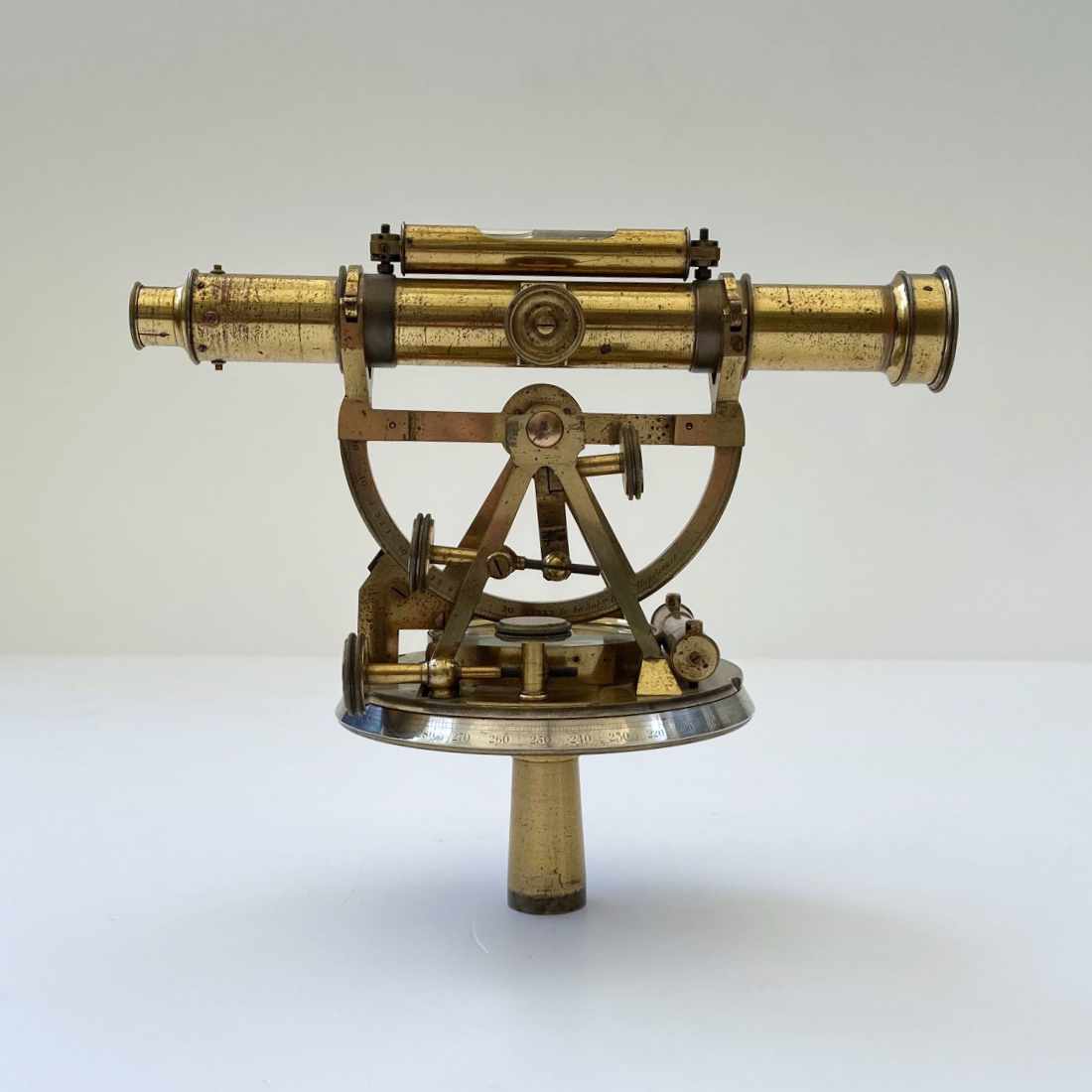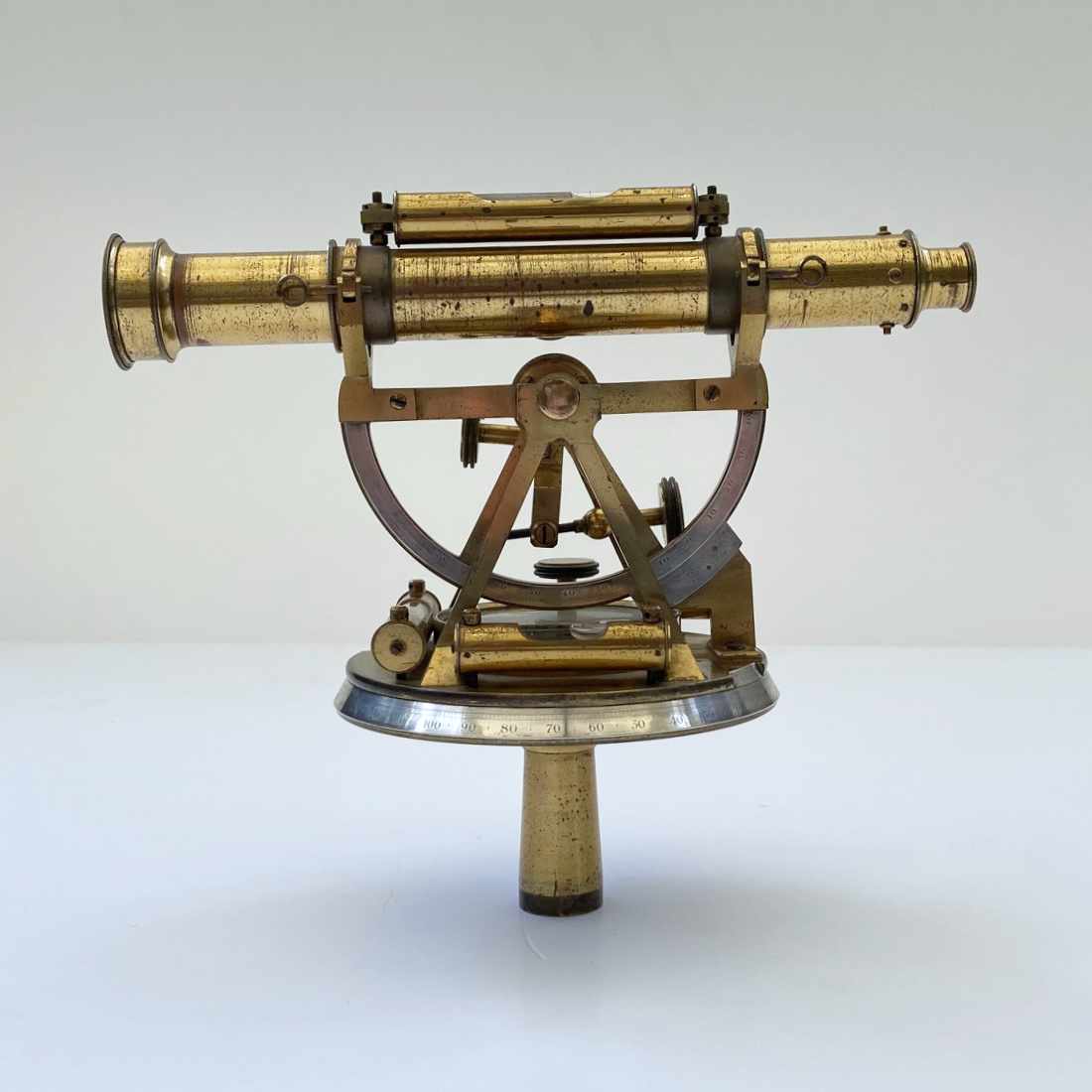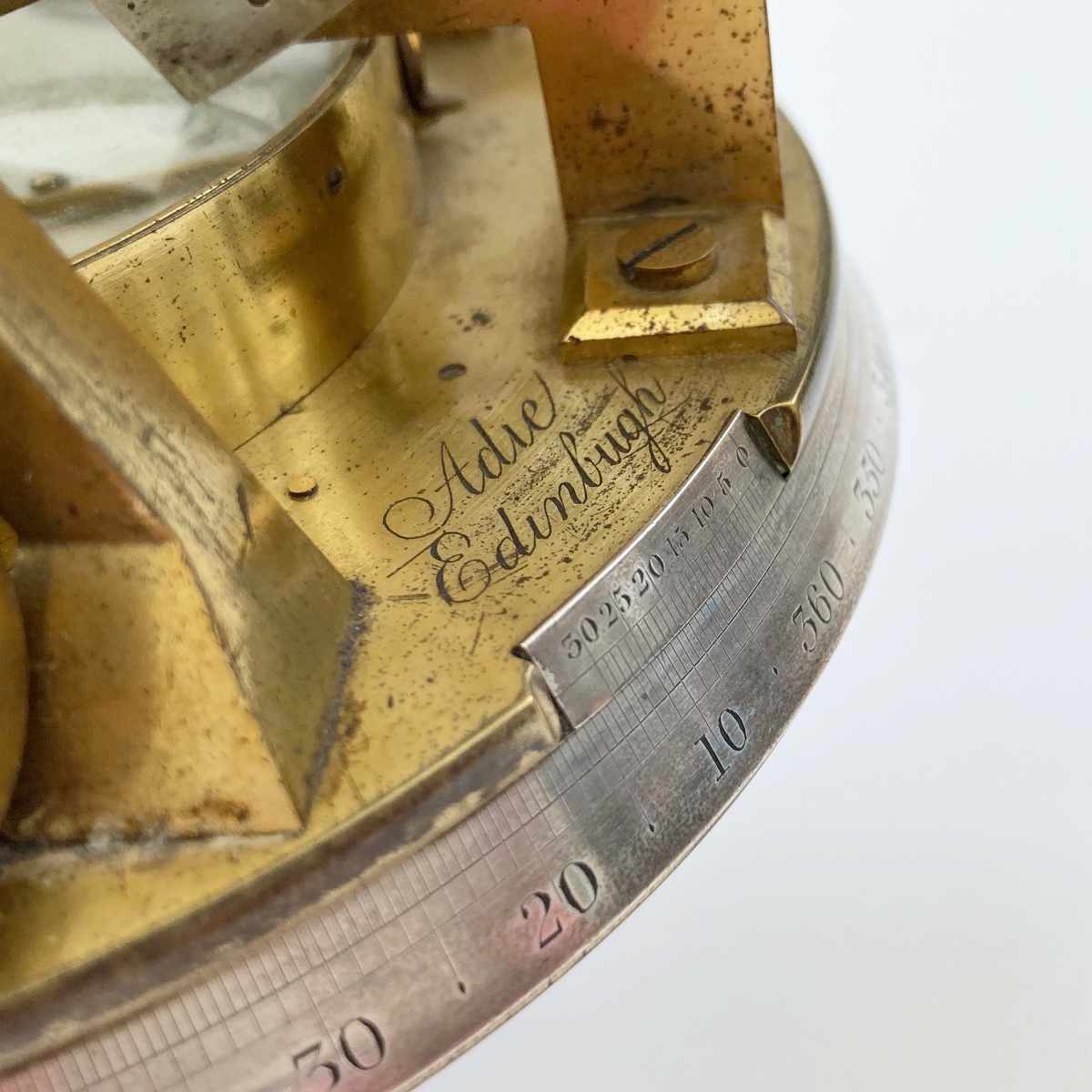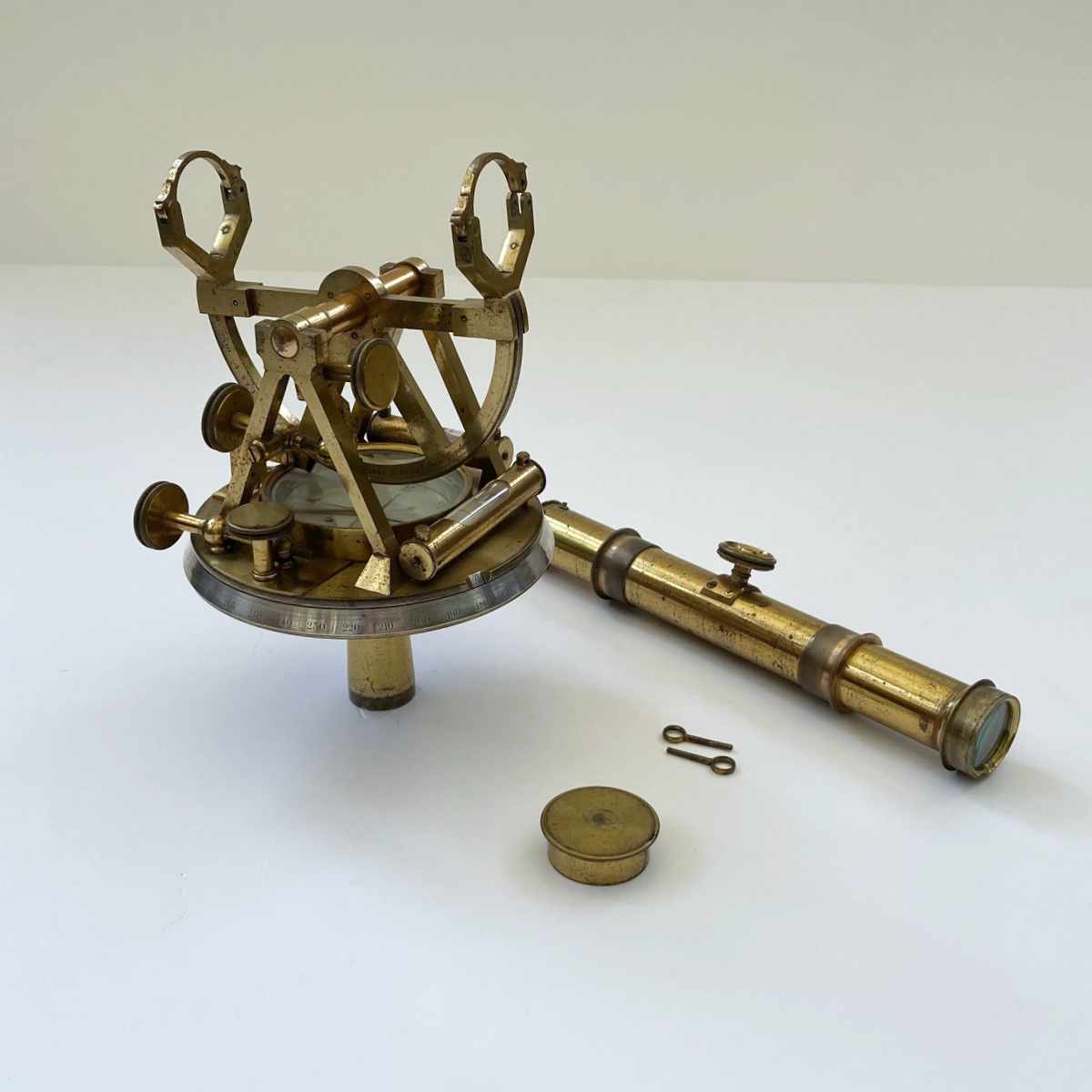Cased George IV Altazimuth Theodolite by Alexander Adie of Edinburgh
£1,495
Cased George IV Altazimuth Theodolite by Alexander Adie of Edinburgh
Dimensions
H: 15 x W: 28 x D: 26cms
Circa
1820
Maker
Alexander Adie of Edinburgh
Country of manufacture
UK and Ireland
Description
For sale, a cased George IV altazimuth theodolite by Alexander Adie of Edinburgh.
This rare example is comprised of a horizontal five-inch divided circle which is coarse adjusted by hand and then finely adjusted by means of a knurled brass knob attached to top. The centre contains an expertly engraved and silvered compass with a small brass cam to the side of the case, to hold or release the movement. Two sides of the outer edge of the base are also provided with glass bubble levels housed in a protective brass cases.
Two brass A frame type struts either side of the compass provide support for the semi-circular divided arc which is operated similarly for coarse adjustment and then fine adjusted via a brass knob attached to the A frame. The arc is further completed with a ten-inch telescope and attached glass level, again housed in a protective brass sleeve.
Below the horizontal base is attached a brass shaft for fixing to a tripod.
The model bears great similarity to a double telescope example I have previously sold by Miller & Adie, Alexander Adie’s earlier partnership. The design first appeared in George Adams Junior’s publication, “Geometrical and Graphical Essays” in 1791 relating to design improvements made by Jesse Ramsden. John Miller had also previously worked under George Adams Senior and so this particular design would have been passed from Adams to Miller and presumably taught to Adie.
This example is also interesting for its singular engraved signature stating “Adie Edinburgh”. The majority of Adie instruments are marked to Adie & Son in recognition of the multi generational involvement. Instruments marked solely to Adie (Edinburgh) may be recognised as belonging to the twenty year period between the partnership of Miller & Adie (to 1815) and the creation of Adie & Son in 1835. Examples of this period are surprisingly rare.
The firm of Miller & Adie was the original firm that gave birth to the Adie dynasty of famous scientific instrument makers that dominated Nineteenth century instrument making. It began in 1776 with the celebrated Edinburgh scientific instrument maker John Miller (1746-1815). The son of an Edinburgh turner, Miller was apprenticed (or simply worked) under the world-renowned maker George Adams and eventually returned to Edinburgh from London in 1769. He is listed as trading from various Edinburgh addresses from 1775 and received early commissions from the physician Dr James Lind.
In 1776, Lind left Edinburgh but by that time, Miller’s reputation had already grown to such an extent that he had begun equipping the classroom and laboratories of Edinburgh University on behalf of John Robinson, who had recently been appointed to the Chair of Natural Philosophy there.
Four years prior to this date, Miller’s sister Betty had married John Adie, a printer and proprietor of The Edinburgh Evening Courant. The pair had two sons with the second (Alexander Adie) being born in January 1775 just three months after his father’s early death. Betty died shortly after, leaving John Miller’s father (also John) to look after and adopt the young Alexander. Originally employed as a stocking maker, the death of his remaining old brother in 1787 finally led Alexander to the employment that would culminate in a partnership with his uncle.
From 1789, Adie (1775 – 1858) began his apprenticeship with Miller and by 1803, a partnership was agreed which traded at various addresses on South Bridge & Nicholson Street. This early period accompanied a boom in surveying activities in Scotland and theodolites, levels and measuring chains featured heavily in their advertising.
Miller & Adie continued to trade until 1822 (although Miller had died by 1815) whereafter the business was renamed solely to Alexander Adie. By this point, Adie was himself an accomplished maker with a focus on meteorological instruments and had by 1818 taken out a patent (No: 4323) for a sympiesometer, a type of barometer designed initially for marine use which contained hydrogen and almond oil instead of mercury. Perhaps the most well-known instrument that the Adie family are now recognised for, this invention was patented as, “An improvement on the air barometer” an instrument that had been conceived as early as 1668 by Robert Hooke but never brought into practical use until Adie’s later developments.
By 1822, Adie had a family of three sons, John (1805-1857), Richard (1810-1881) and Patrick (1821-1886) and it is sensible to presume that all undertook some kind of apprenticeship under him. The eldest, John went into business with his Father to form Adie & Son in 1835 and Richard is also known to have worked for the firm. Like many scientific instrument making firms of the period, both Richard and Patrick were to go on to set up their own successful satellite firms under their own names both in Liverpool and London respectively.
In Edinburgh, the partnership between Alexander and John continued to grow, they received Royal Appointments from both William IV and Queen Victoria and were the only two instrument makers elected as Fellows of The Royal Society of Edinburgh. The links with the Society are considered to be the reason for their commission to build William Wallace’s patent Eidograph, an improvement to the less accurate pantograph. They had trading links with Spencer, Browning & Rust (they retailed Adie’s Sympiesometer) and John completed the installation of a Troughton & Simms altazimuth circle for The Edinburgh Astronomical Institution at Calton Hill Observatory after Simms proclaimed himself too busy to undertake the exercise! They were also known to have had links with Charles Darwin.
Sadly, John shot himself in 1857 after suffering from, “fits of despondency” and therefore predeceased his father who died the following year. The Royal Society wrote of John:
“Mr Adie’s enrolment among us is a sufficient proof that he successfully followed his calling. He was greatly esteemed as a man conversant with the highest branches of his profession, and who has left behind him in that respect scarcely and equal, certainly no superior, in Edinburgh, or perhaps in even in London itself”.
They went on the following year to say of his father Alexander:
His attention to business, with his skill as a mechanic, his quick inventive powers, and his sound judgement, led him to his being much employed by all kinds of inventors to give their schemes a practical form.”
Following the sad demise of both partners of the firm, Richard Adie continued to run both the Edinburgh firm and his own concern in Liverpool until his eventual death in 1881. Himself an accomplished instrument maker, Richard was awarded a silver medal by The Royal Scottish Society of Arts for his developments in meteorological instruments and published twenty seven papers on philosophical instruments between 1837 & 1868. He also exhibited a vacuum steam gauge, an alcohol hermetic barometer and a double telescope at the 1862 London
On the death of Richard, the company was sold to Thomas Wedderburn who had been the Adie family’s foreman at the firm and the name was changed to Adie & Wedderburn. He died in 1886 whereafter the business was again sold to an Alexander James Menzies who also died a year later and the firm was finally handled by an optician named Thomas Mein.
The firm of Patrick Adie, the youngest of the brothers continued to flourish in London. Set up in 1844 after serving apprenticeships with both his Father’s firm and the gas engineers, Milne & Son, he also specialised in the production of meteorological instruments. Through contacts made during his apprenticeship and training at Sir Thomas MacDougall Brisbane’s observatory near Kelso, Patrick had close links with John Welsh Superintendent of The Kew Observatory. An international conference had taken place in 1853 for the purpose of promoting meteorological observations at sea and numerous recommendations were adopted by the British Government. They encouraged the Kew Committee of the British Association to develop some of these ideas and both Welsh & Adie worked together to develop the now famous “Kew Pattern” barometer, a fitting development to his father’s earlier work.
Adie himself developed a number of instruments during his lifetime including the first coincidence rangefinder used in astronomy. He exhibited numerous patent instruments at the Great Exhibition, The Paris Exhibition of 1855 and at the London Exhibition of 1862 and gained medals for his meteorological instruments. Close links were also garnered with the civil engineering industry, and his instruments were used as part of the great trigonometrical survey of India and in the construction of railways at home and abroad.
Adie eventually died in 1886 from bronchitis and heart disease and upon his death, the Institution of Civil Engineers (of which he had been a member since 1865) wrote:
“That Mr. Adie possessed great inventive power is shown by the fact that he took out no less than twelve patents, many of which are well known, and have proved very successful. One of these patents he was engaged in perfecting at the time of his death. It consists in the employment of corrugated steel belting, in lieu of leather, which he believed would effect a large saving both in power and cost. In this opinion he was supported by some eminent Members of the Institution, to whom he was well known, and who frequently sought the advice which his great experience enabled him to give.”
His business continued until 1942 presumably under family ownership although the latter history of this London firm remains largely unclear. Adverts from this later period for cement making machines suggest a closer association with industry rather than retail. It is perhaps not surprising to learn that the publisher of the book which includes the Goodman’s extensometer description was himself a member of the Concrete Institute so it reflects that the Adie Company continued providing instruments for those at the cutting edge of industry even at this late stage in the company’s history.
Circa 1820






















